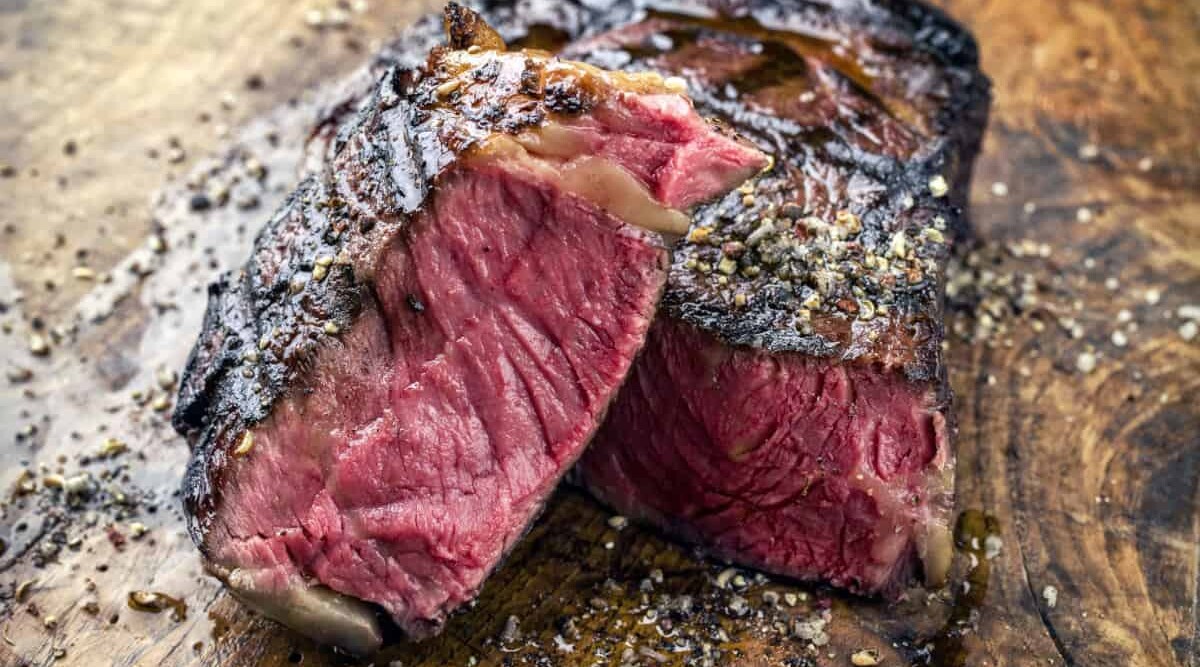
Blue steak, also known as ultra-rare or simply blue, has a light sear on the outside and a vibrant red interior. People who enjoy tender meat love this steak because it’s cooked super-quickly and has a juicy, smooth internal texture.
In this article, we take a detailed look into the fascinating world of blue steak. We cover everything from the origins of the name, to its key characteristics, and any safety concerns. We also help you pick the right cuts for blue steak and give you step-by-step instructions on how to prepare and cook it to perfection.
So, if you want to try something new and are willing to discover the wonders of blue steak, keep reading!
Key Takeaways
- Blue steak, also known as ultra-rare or blue rare, has a light sear on the outside and a vibrant red interior.
- Blue steak is cooked very briefly, leaving the center cool and barely cooked, and is preferred by those who enjoy the natural flavors and textures of the meat.
- The name “blue” comes from the deep purple hue seen in freshly cut beef, which quickly turns red when exposed to oxygen. It may also come from the French term “Au Bleu” or suggest the steak’s raw condition.
- Blue steak is safe to eat if cooked properly, as the sear kills bacteria on the meat’s exterior. It’s important to sear all sides of the steak thoroughly.
- Blue steak has an internal temperature of 115°F to 120°F.
- The best cuts for blue steak include sirloin tip, top sirloin, round steak, flat iron, and filet mignon. Lean and tender cuts work best.
- Cuts to avoid include porterhouse/T-bone, ribeye, skirt steak, flank steak, flap steak, hanger, bottom sirloin, and any cut of wagyu or Kobe due to fat marbling.
- To cook a steak to blue on a grill, preheat the grill to high heat, sear the steak for a short time on each side, and sear the sides as well.
Jump to:
- 1 Key Takeaways
- 2 What is Blue Steak?
- 3 Why is it Called Blue Steak?
- 4 Is Blue Steak Safe to Eat?
- 5 Comparing Blue Steak with Other Levels of Doneness
- 6 What are the Best Cuts for Blue Steak?
- 7 Which Cuts Should You Not Cook Blue? Why Not?
- 8 What Temperature to Cook Blue Steak to?
- 9 What Does Blue Steak Taste Like?
- 10 What Texture is Blue Steak?
- 11 How to Cook a Steak to Blue on a Grill
- 12 Final Thoughts
What is Blue Steak?
A blue steak, also known as “Blue Rare” or “bleu,” is a steak that you cook very briefly , leaving the center cool and barely cooked. The outside of the steak is seared for a short time, while the inside remains mostly raw.
This doneness level is a step below rare on the steak doneness chart. It is preferred by people who like the meat’s natural flavors and textures that change with longer cooking times.
Please note that blue steak is not raw steak. It has been cooked, albeit minimally.
Why is it Called Blue Steak?
It’s tough to get a consensus on this, but the most accepted reason for calling blue steak ‘blue’ is it comes from the deep purple hue seen in freshly cut beef. The color is a result of the protein, myoglobin. After cutting, though, it quickly turns red when exposed to oxygen.
Many others say it comes from the French cooking term “Au Bleu,” which translated means ‘to blue’, offering insight into this steak’s level of doneness. ‘Au Bleu’ is a way to cook fish in a broth made of water, vinegar, and spices. Applied specifically to trout, this cooking style turns the fish bluish.
I have also read some say ‘blue’ might suggest the steak’s raw condition.
Another theory is because the color “blue” represents “cold” or “cool,” which the interior of a blue steak should be.
Is Blue Steak Safe to Eat?
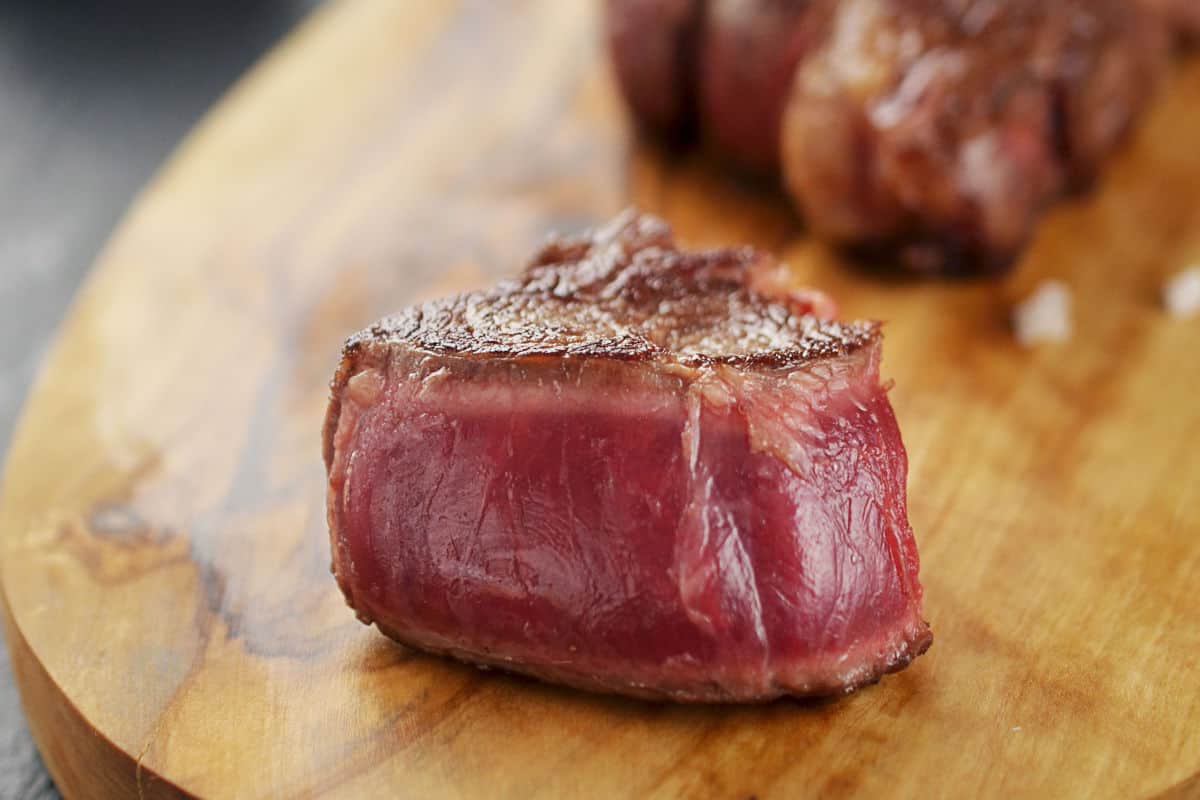
Yes, blue steak is safe to eat. Though steak this raw may not be for the squeamish, it’s perfectly safe if cooked properly. The key to cooking blue steak is the sear, because searing kills the bacteria on the meat’s exterior. Since the bacteria cannot possibly be inside the steak, exposure to high temperatures on the outside is all you need to make it safe to eat.
However, it is crucial to sear not only the top and bottom of the steak but also all the sides. Steaks cooked to higher doneness levels are on the heat long enough to cook the sides sufficiently to kill pathogens without direct contact with the grate. On the other hand, a blue steak is on the cooking surface for a very short period, so it’s necessary to cook the edges (every inch of surface!) as well.
Comparing Blue Steak with Other Levels of Doneness
Blue steak has an internal temperature notably lower than other steak doneness levels. Let’s see how it compares:
- Blue (or Bleu)
- Internal Temperature: 115°F to 120°F (46°C to 49°C)
- Taste and Texture: A very soft texture, similar to raw meat, and a strong beefy flavor
- Rare
- Internal Temperature: 120°F to 130°F (49°C to 454°C)
- Taste and Texture: Cooked slightly more than blue steak but is still very red in the center. It’s soft, juicy, and has a pronounced beefy flavor.
- Medium Rare
- Internal Temperature: 130°F to 140°F (54°C to 60°C)
- Taste and Texture: Has a warm, red center and is firmer than rare steak. It’s still very juicy and tender, with a rich beef flavor.
- Medium
- Internal Temperature: 140°F to 150°F (60°C to 65.5°C)
- Taste and Texture: Has a pink center with a bit of brown towards the outside. It’s firmer than medium rare and has a balanced flavor between the beefiness and the flavors developed during cooking.
- Medium Well
- Internal Temperature: 150°F to 160°F (65.5°C to 71°C)
- Taste and Texture: Has only a hint of pink in the center. It’s less juicy than the previous levels and is slightly chewier.
- Well Done
- Internal Temperature: 160°F+ (71°C+)
- Taste and Texture: Has no pink in the center and is brown throughout. It’s the firmest of all the doneness levels and can be a bit dry, with a milder beef flavor compared to the juicier levels.
What are the Best Cuts for Blue Steak?
The best cuts for blue steak include:
- Sirloin tip
- Top sirloin
- Round steak (any)
- Flat iron
- Filet mignon
All these cuts are tender and tasty but tend to have minimal fat intrusions and marbling. Lean and tender cuts work best, without a lot of fat and marbling. You can certainly try to cook any steak blue. But, the results may not be what you hoped for if you use the wrong cuts.
Be sure your steaks are cut thick, at least 1 inch, preferably 1.5 inch or more. A very thin steak will cook through in a hurry, even with, say, 60 seconds of searing.
Which Cuts Should You Not Cook Blue? Why Not?
Cuts to avoid if you want to try blue steak include:
- Porterhouse / T-bone
- Ribeye
- Skirt steak
- Flank steak
- Flap steak
- Hanger
- Bottom sirloin
- Any cut of wagyu or Kobe (however, these can be served raw as sashimi, but only because it’s sliced into very thin ribbons that are easier to chew)
Some of the tastiest steaks are listed above, but they contain a lot of fat marbling which is something to avoid for cooking blue. Fat needs longer exposure to heat to render out and deliver moisture and flavor to your steak. A fatty steak served blue would be riddled with tough and chewy chunks of raw fat. Not an appetizing thought.
For the same reasons, don’t try to cook any low-cost, tough steaks blue. Steaks like these need marinating or tenderizing, and enough time in the heat to break down the tough fibers to make them edible.
As I mentioned in the previous section, thinly cut steaks should also be avoided. By the time you safely sear the entire exterior, you’ll likely have cooked the insides to medium-rare. It’ll be delicious, of course, but it won’t be blue.
What Temperature to Cook Blue Steak to?
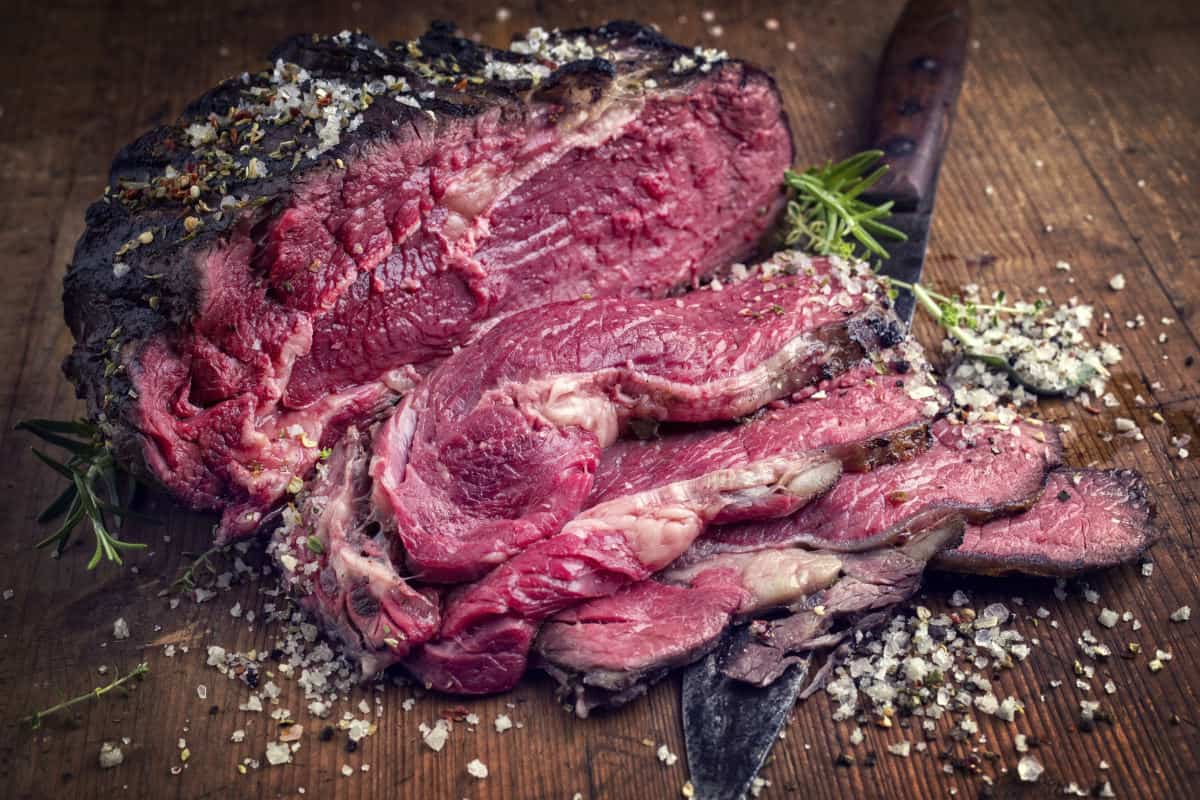
The target internal temperature range for blue steak is between 115 °F and 120 °F.
Any less than 115 °F and it’s basically raw and will be cold. Over 120 °F and we’re getting into ‘rare’ territory, not blue.
What Does Blue Steak Taste Like?
Blue steak tastes like a rich, beefy flavor with a hint of gamey undertone.
Your first point of contact is the seared exterior, and this will taste exactly as you expect — heavy on the umami from the charring and the Maillard reaction. But, as soon as your teeth penetrate the surface, everything changes. There will be contrasting coolness when you reach the uncooked meat, though it should not be cold.
The flavor will vary depending on the cut, of course. In general, you should find it beefy, but maybe not as complex as a steak that’s had a bit longer to cook.
A variant on blue steak is the Pittsburgh steak or “black-and-blue.” This cooking style involves using a lot of butter to char or burn the steak’s exterior at the hottest temperature you can achieve on your grill. The goal is to quickly char the outside but leave the inside as close to raw as possible.
What Texture is Blue Steak?
Blue steak has a soft, cool, and slightly spongy texture. In cooking to higher doneness levels, heat breaks down beef proteins, making the meat more tender. But blue steak isn’t hot enough to achieve this magic, so you’ll likely find it chewier and even a bit spongy compared to even a medium-rare steak.
Of course, all that extra chewing allows you to experience the flavor for even longer, creating a very satisfying experience if your steak is naturally flavorful.
How to Cook a Steak to Blue on a Grill
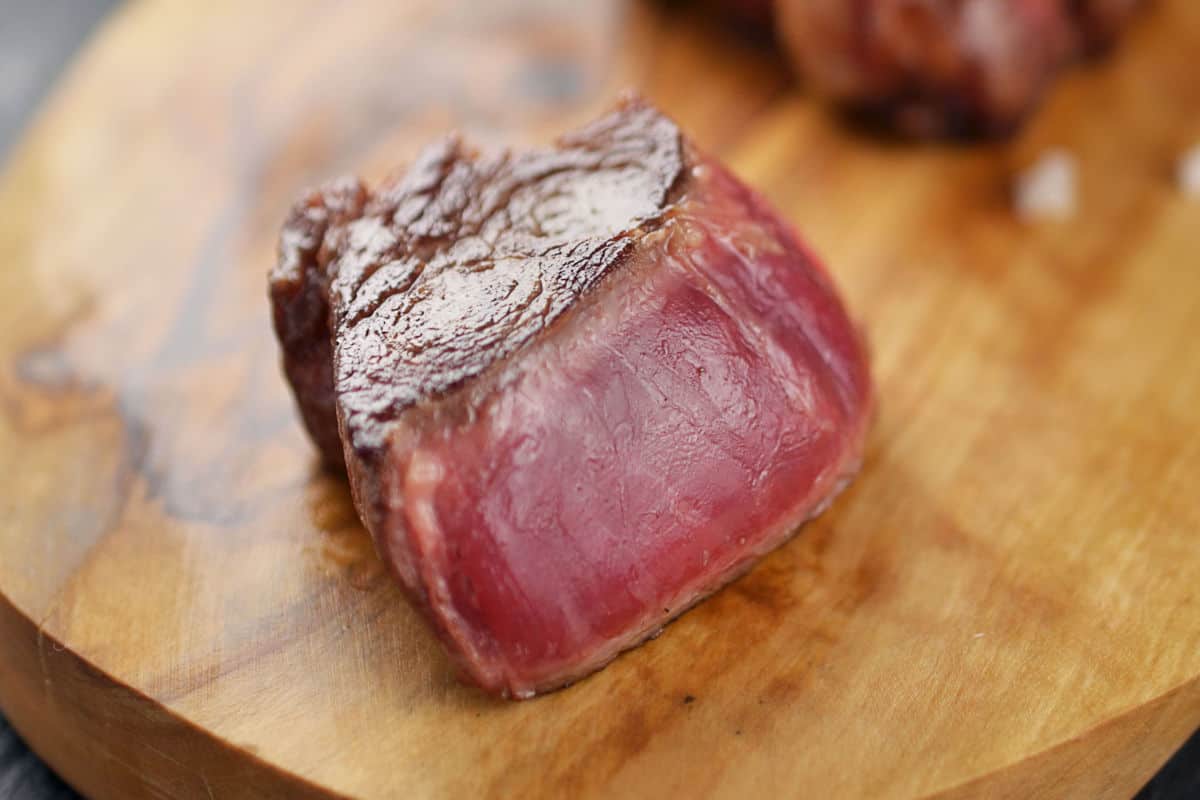
Is your mouth watering? Ready to try cooking a blue steak for yourself? Here’s how it’s done.
- If it isn’t already, allow your steak about 15-20 minutes to come up to room temperature.
- While that’s happening, preheat your grill. Aim to get it screaming hot; burners on full, or a load of charcoal with the vents wide open.
- If you like, brush olive oil on the surface of your steak for additional char. You can also add seasoning at this point.
- Once your grill is as hot as it will get, place the steak on the grate over direct heat. Leave the lid up.
- Allow the steak to sit for no more than a minute before flipping it to the opposite side. When you flip, move the steak to another part of the grate for maximum heat.
- After a minute on the second side, grip the steak with tongs and begin searing the sides. You’ll have to “roll” the steak around to make sure every portion of the side contacts the grate long enough to develop a sear.
- Remove from heat. An instant read thermometer inserted into the steak should read between 115 °F and 120 °F. If it’s at or above 120 °F, carryover cooking may take it from blue to rare.
- Serve and enjoy immediately!
By the way, there’s no reason to rest a blue steak. Resting a steak allows liquids squeezed by contracting fibers to redistribute after exposure to high temperatures. With a blue steak, the interior doesn’t get hot enough for this to become a problem.
Final Thoughts
Now that you know eating blue steak is perfectly safe and how to cook one properly, are you ready to give it a go? Not everyone likes blue steak, but it’s worth trying. Some steak lovers believe it’s the best way to taste the true flavor. It’s certainly full-on carnivorous behavior!
If you try it, let us know how it went and what you thought! Send an email, leave a comment below, or find us on social media and leave a few words.
However you like your steak (yes, even if it’s well done), thanks for reading, and may your grates never rust.


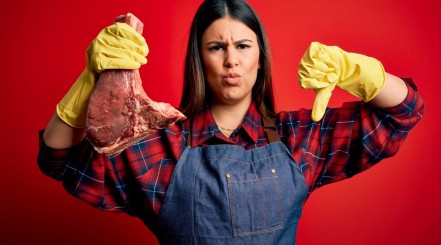
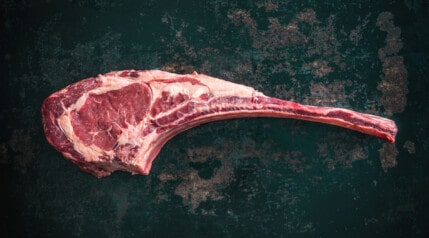
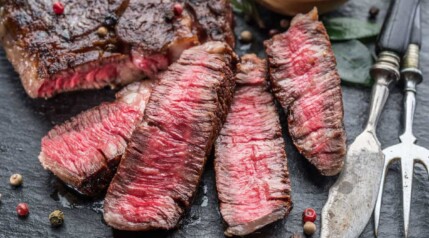

This is the best explanation & cooking guide for my beloved blue beef which I’ve seen. May I say EVER!
FINALLY, my husband can truly understand my affinity for a nice blue steak & will lovingly make one for me. I’ve always had to prepare my meats myself. .
I’m all about leaning toward the carnivore side of the omnivore spectrum.
Cheers & Bon Appétit/buen provecho. Am I coming to dinner?
Thanks, Marti!
I think you have a misprint in the line: “Any less than 115 °F and it’s basically rare and will be cold. Over 120 °F and we’re getting into ‘rare’ territory, not blue.”
Shouldn’t it read “…basically raw…”?
Hi Peter,
You’re absolutely right, thank you for pointing it out. I’ll correct it now.
Can A fairly thick rib eye steak be cooked “ Blue “ and be really good?
Hi, John. I wouldn’t use a ribeye to be honest, you’d have lots of unrendered, raw fat that wouldn’t be nice to eat. You want to use lean cuts that don’t have much fat in them
I have had a ribeye cooked blue (the ONLY) and it was wonderful. Mind you, it was in Texas, so there’s that.
Surprising! I’ve honestly never seen a ribeye offered blue…but it is done if you’ve had one!
English is not my first language. But, your explanation is very complex and easy for me to understand. Thankyou Mr.Jim 🤟🤟🤟🤟
I love blue steak! Just made a Wagyu ribeye blue and it was perfect. I had no problem with all that marbling; it was tasty. I never rest a blue steak and mine never “bleed.” The temp I usually go for is about 100-105°. So basically, it’s just season, sear and eat. Works for me!
I think you might have given too little attention to bringing the raw steak to room temperature. It must come out of the fridge well before cooking. Even then you might have to keep turning it for some time on the stove top until it is up to room temperature. Any tips?
Hi Peter. The problem is, although ‘Leave it to come up to room temperature before cooking’ is a very, very common thing people say, it’s completely impractical and also dangerous. It takes many hours for even a medium thickness steak to get anywhere close to room temperature, during which time the surface will have spent way too much time in the ‘temperature danger-zone’ in which bacteria multiply, making it unsafe to eat. Most people say to leave a steak out for 20 to 30 minutes. In this time, the core internal temperature will only rise 2 or 3 degrees F. Even after 2 hours, it will only rise 10 deg F and still be nowhere near room temp. I keep meaning to do a write up on this, and when I do I will add a link to it from this comment thread.
As for tips if wanting blue steak? Have you pan incredibly hot, and sear the outside very well, hot and fast, then take it aside and rest. The surface will be VERY hot, while the center is still cold. Over time, due to carry over cooking, the surface heat will travel in and warm the center. Wait it out a while until it equalizes and if not a sufficient temp inside, rinse and repeat. This will help to ensure you do not overcook it.
You could also try sous vide or a hot water bath. Set it to 110 deg F, seal your steak in a bag, drop it in until cooked through, and then sear really hot and fast.